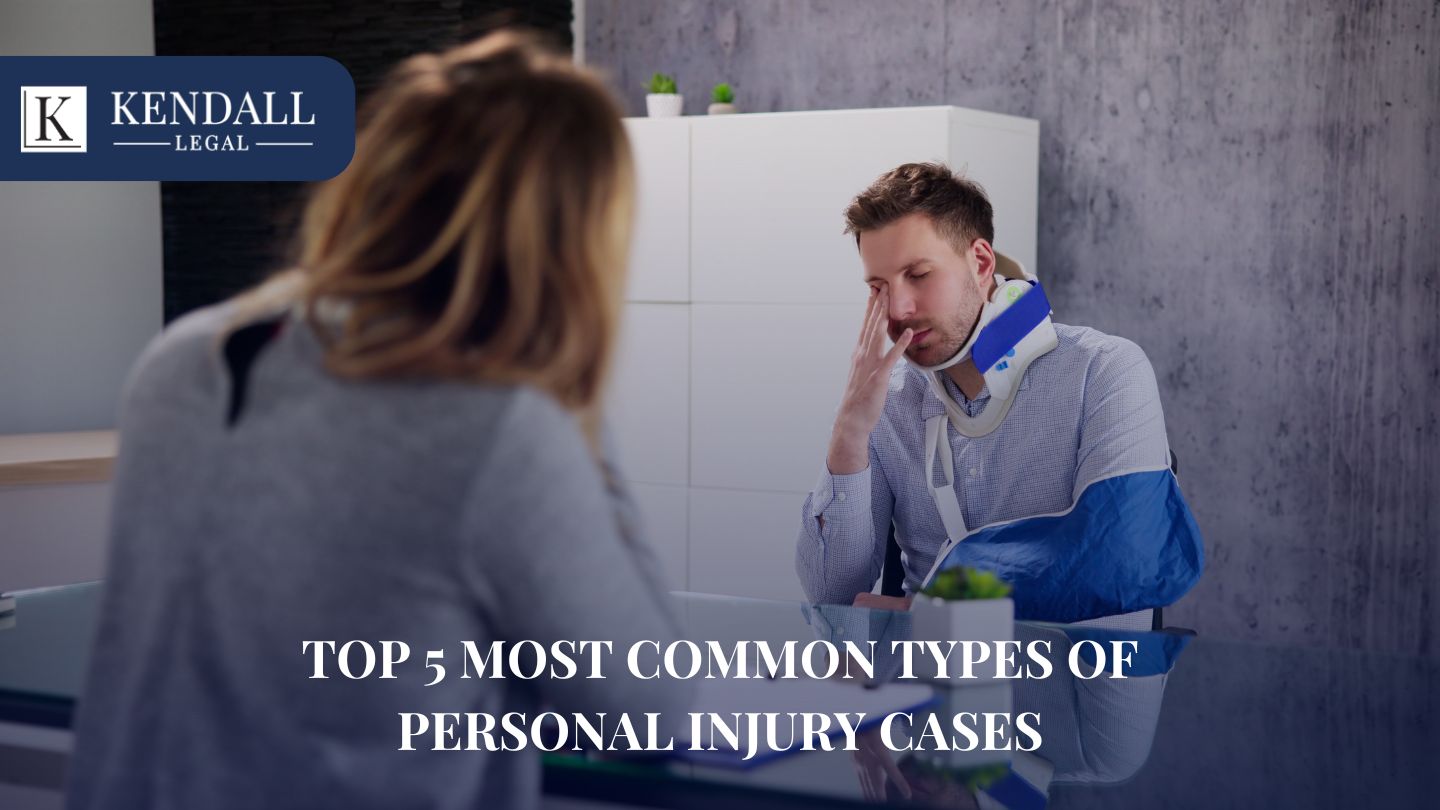
Want to know the most frequent personal injury cases? This blog uncovers the 5 most common types of personal injury cases to help you understand these scenarios better.
Key Takeaways
- Car accidents are the most prevalent cause of personal injury claims, often resulting from factors such as speeding, drunk driving, and distracted driving.
- Slip and fall accidents fall under premises liability law, requiring property owners to maintain safe conditions and warn of hazards to avoid legal repercussions.
- Medical malpractice claims involve failures in the standard of care by healthcare providers and can be complex, necessitating expert testimonies to support the cases.
Car Accidents: The Leading Cause of Personal Injury Claims
In the United States, car accidents are a predominant cause of personal injury cases. Incidents on the road can range from minor collisions to severe crashes resulting in significant injuries or even death. Those affected by car accidents often endure numerous hardships, including escalating medical expenses, income loss due to inability to work, and mental suffering. Personal injury claims and lawsuits play a vital role in providing financial relief and ensuring accountability for those at fault.
Drivers are expected to adhere strictly to traffic regulations and remain attentive behind the wheel as part of their responsibility toward safety. Failing this duty can lead to dire outcomes resulting from a motor vehicle accident. Compensation claims arising from such incidents typically aim to recover costs associated with healthcare treatment, foregone earnings due to time off work, and pain and emotional anguish endured.
A clear understanding of both the typical causes of vehicular accidents and the importance of immediate legal representation can significantly influence the outcome of a personal injury case. Prompt legal intervention helps preserve evidence, protect rights, and initiate a structured approach to pursuing compensation, especially in incidents involving catastrophic injuries, pedestrian impacts, and long-term disability.
Common Causes of Car Accidents
Various elements, many attributed to human error, can initiate car accidents. Key factors include:
- Speeding often results in a loss of control over the vehicle, leading to significant collisions.
- Drunk driving endangers not only the driver but everyone else on the roadway.
- Distracted driving continues as a pressing concern. Activities like texting while driving highlight why accountability is crucial.
Recognizing these contributors is essential for promoting safe and responsible driving practices. Car accidents are frequently at the core of personal injury cases. Awareness of these prevalent triggers can aid in preventing such events and advocating for fairness should an accident transpire, especially when it involves grave outcomes such as unintentional injury, motorcycle or motor vehicle crashes, and traumatic brain injuries. In instances where an injury occurs due to a vehicular mishap, obtaining legal counsel becomes imperative for guidance on managing sustained injuries and safeguarding one’s rights.
Steps to Take After a Car Accident
After a car accident, it’s critical to receive a full medical evaluation. Legal professionals can initiate documentation efforts immediately, including requesting official accident reports, securing witness statements, and overseeing evidence preservation, such as photographs or surveillance footage. Relying on professional legal assistance early ensures a stronger foundation for building a compelling injury claim.
Seeking assistance from an experienced personal injury attorney can significantly enhance your chances for a successful claim outcome. These attorneys are well-versed in navigating through the intricacies of personal injury law, and they work towards securing just compensation for any physical or emotional damage sustained, along with other losses incurred. Addressing these matters swiftly can have a profound impact on both healing physically and progressing legally after such incidents.
Slip and Fall Accidents: Premises Liability Cases

Slip and fall accidents, a common type of personal injury case, fall under premises liability law. These incidents occur when someone trips or slips and gets hurt on someone else’s property. Common locations for slip and fall accidents include stores, restaurants, sidewalks, and private homes. Property owners are required to maintain safe premises and warn visitors of known hazards.
Unsafe conditions that result in injuries can make property owners legally liable. Personal injury claims in these cases aim to cover medical expenses, lost wages, and other damages resulting from the accident. Knowing common locations and how to prove negligence is essential for anyone involved in these incidents.
Common Locations for Slip and Fall Accidents
Different settings come with their own risks that often result in slip-and-fall incidents. Notable places where these accidents occur include:
- Grocery shops and retail stores, due to slippery surfaces or cluttered walkways
- Work environments, which are prone to a higher number of falls as a consequence of neglect or hazardous conditions
- External areas such as pavements and car parks, which frequently witness these types of mishaps
Understanding where these accidents frequently occur allows legal professionals to investigate liability more effectively. By assessing maintenance records, hazard reports, or surveillance footage from these locations, attorneys can build a strong case linking unsafe conditions to the resulting injury.
Proving Negligence in Slip and Fall Cases
Establishing negligence is essential for the success of a slip and fall personal injury claim. To accomplish this, it’s necessary to demonstrate that the property owner had a legal duty to keep the injured party safe by either addressing known hazards or warning about them, but failed in their responsibility. Often, this involves showing neglect in maintenance or a lack of warnings regarding existing dangers.
It must also be proven that there was a direct link between the breach of legal duty by the property owner and where the injury took place. Evidence collection is key—witness accounts, images from where the accident occurred, and records pertaining to upkeep play crucial roles in pinpointing who bears responsibility for what happened.
Legal professionals play a crucial role in interpreting these liability elements and establishing fault through detailed investigation, expert testimony, and compliance assessments. A proper legal strategy increases the likelihood of a favorable outcome in slip and fall claims.
Medical Malpractice: When Healthcare Goes Wrong

When health care professionals fail to uphold the established standard of care, it can result in medical malpractice. Such negligence can cause serious harm or even wrongful death, shattering the trust that patients have in their medical providers.
Legal action may be pursued against the responsible provider or healthcare institution, with legal teams focusing on proving deviations from accepted care standards through comprehensive case review and collaboration with medical experts.
Common Types of Medical Malpractice
Medical negligence can manifest in various ways, all of which may result in severe injuries for the patient. Notable examples include:
- Mistakes during surgery, such as conducting an incorrect operation or failing to remove surgical instruments from the body.
- Incorrect or belated diagnoses that lead to improper treatment or a delay in receiving appropriate care, exacerbating the health issue at hand.
- Prescription mishaps involving wrong dosages or dangerous combinations of medication.
These types of incidents pose significant risks to patient well-being and overall medical outcomes.
The occurrence of these errors highlights the essential need for meticulous attention and compliance with established medical protocols. Patients who endure serious harm due to this form of neglect are entitled to pursue legal action and claim restitution for their suffering.
Legal Challenges in Medical Malpractice Cases
Claims of medical malpractice are infamously complex and necessitate comprehensive scrutiny. To substantiate such a claim, evidence is required to show that the conduct of the healthcare provider did not align with the acknowledged standard of care in the profession. Often, this will involve securing testimony from experts who can clearly define what constitutes appropriate care and pinpoint how it was not met.
Another considerable hurdle is establishing a direct causal relationship between medical negligence and the harm suffered. Legal professionals address this by working with independent medical experts to dissect clinical records, identify procedural failures, and present substantiated arguments that align with medical-legal expectations.
Understanding these formidable legal obstacles is essential for anyone considering pursuing litigation over suspected medical malpractice.
Workplace Accidents: Injuries on the Job

Accidents at work, frequently caused by insufficient or overlooked safety measures, are a prevalent source of personal injury and workplace injuries. It is the legal responsibility of employers to ensure their workers have a safe environment in which to work. Failure to fulfill this obligation can result in mishaps that lead to significant harm, including severe physical injuries or fatalities due to these incidents.
Employees injured due to third-party negligence or unsafe conditions, particularly when caused by vendors, contractors, or defective equipment, may be eligible to file a personal injury claim in addition to any workers’ compensation benefits. Legal professionals assess whether external liability exists and explore avenues beyond the standard workers’ comp system to recover damages such as pain and suffering, which are not covered under traditional employer benefits.
Common Types of Workplace Accidents
Workplace accidents can occur in a multitude of forms and environments. Common incidents in particularly risky workplaces include falls from heights, mishaps involving machinery, and contact with hazardous substances. In the construction industry, scaffolding collapses and debris that falls are frequent sources of harm to workers. Meanwhile, repetitive stress injuries can afflict employees even in settings considered less dangerous due to poor ergonomic practices or incorrect manual handling techniques.
Acknowledging these typical workplace accidents is crucial for pinpointing potential hazards and taking steps toward prevention. It is imperative for employers to focus on safety as a top priority to safeguard their workforce and reduce the frequency of such events.
Workers’ Compensation vs. Personal Injury Claims
Employees who sustain injuries on the job can take advantage of workers’ compensation, a system that doesn’t require them to prove their employer was at fault. This setup streamlines the process for these employees, allowing them to receive coverage for medical bills and income they’ve missed out on without engaging in protracted legal disputes.
Personal injury claims, filed in cases involving external parties or gross negligence, may lead to broader compensation, including for pain and suffering or punitive damages. Legal professionals guide injured workers through this complex distinction to determine which route provides the most comprehensive recovery based on the facts of the incident.
Understanding how these types of claims differ is essential when considering options for seeking restitution after suffering a workplace incident.
Product Liability: Defective Products Causing Harm
Cases of product liability arise when consumers are harmed by products that are defective and potentially hazardous. These instances can be intricate, often involving the pursuit of accountability from manufacturers, distributors, and retailers for any injuries incurred. The laws surrounding product liability aim to safeguard consumers by guaranteeing that only safe products reach the market.
Identifying the specific type of product defect enables legal teams to determine the liable parties—whether the manufacturer, distributor, or retailer. With proper legal representation, victims can pursue claims that expose negligence in product design, testing, or warnings, ensuring accountability within the supply chain.
Types of Product Defects
Three primary categories of product flaws exist: design defects, manufacturing defects, and insufficient warnings. Design defects render a product intrinsically hazardous before production takes place. On the other hand, manufacturing defects arise amidst the creation process and impact only a portion of the items in a particular series.
Insufficient warnings stem from not providing consumers with adequate information regarding possible dangers associated with using the product.
Examples of Product Liability Cases
Various defective products can lead to product liability cases, including:
- Vehicles with faulty tires or brakes can result in serious accidents and harm.
- Pharmaceuticals that cause adverse effects due to their hazardous nature.
- Toys that are flawed and could cause choking.
There are many other typical instances.
In each case, legal professionals gather technical documentation, safety recalls, and expert opinions to demonstrate the defect’s role in the injury. These examples highlight the broad scope of product liability litigation and the need for legal expertise in proving fault across different industries.
Wrongful Death: Seeking Justice for Lost Loved Ones
When an individual’s death is the result of another person’s negligence or a deliberate action, wrongful death claims may be filed. These circumstances are not only emotionally wrenching but also have significant financial implications for the deceased’s relatives. In instances involving intentional torts that lead to wrongful death, retaining an experienced personal injury attorney can prove invaluable in managing legal intricacies and pursuing justice.
Legal professionals handling wrongful death cases navigate these claims with sensitivity and precision, securing financial compensation and bringing clarity to grieving families during a deeply difficult time.
Common Causes of Wrongful Death
Claims of wrongful death often arise from a variety of personal injury incidents. Frequently, fatal consequences result from car accidents due to careless driving or breaches of traffic rules. Another prevalent cause is medical malpractice, where mistakes such as incorrect diagnoses, errors during surgery, or inappropriate medication administration can lead to the demise of a patient. Deadly injuries may occur due to workplace mishaps, especially in danger-prone sectors like construction.
Demonstrating negligence requires a detailed legal strategy supported by evidence like expert analysis, violation reports, and occupational safety audits. Legal counsel ensures these cases are approached methodically to meet the burden of proof necessary for success.
Pinpointing the fundamental reason behind the tragedy assists families in maneuvering through the judicial process and aids them in claiming rightful compensation.
Legal Process for Wrongful Death Claims
The process for filing wrongful death claims encompasses multiple crucial steps. Initially, there must be a determination that the individual’s death was caused by another party’s fault under legal standards, which may include actions such as negligence or even intentional harm. Accumulating robust evidence, including witness testimony, health-related documentation, and reports detailing the incident, is essential to fortify the claim.
Legal professionals manage every aspect of a wrongful death case—from investigating the cause and identifying liable parties to representing the family in negotiations or court. This structured approach supports families through legal challenges and helps secure the justice they deserve.
Pursuing a wrongful death lawsuit with diligence and care provides not only potential monetary relief but also could deliver a measure of justice to those relatives left behind after such untimely passing events.
Summary
In conclusion, personal injury cases cover a diverse array of situations—from car accidents and slip and fall injuries to medical malpractice, product liability, workplace injuries, and wrongful death. Each case type presents its own unique challenges that require expert legal guidance to navigate successfully.
At Kendall Legal, we pride ourselves on being a leading injury lawyer in Atlanta, GA. Our commitment lies in protecting our clients’ rights and maximizing their compensation. Whether you’re confronting a minor injury or dealing with the aftermath of a tragic event, our team provides the expertise and compassion necessary to guide you through every step of the process. Ready to take action? Contact us today.
Frequently Asked Questions
Can multiple parties be held responsible in a personal injury case?
Yes, liability can be shared among several parties if more than one contributed to the injury, depending on the evidence and local comparative fault laws.
What types of damages can be claimed beyond medical bills?
In many cases, victims can also seek compensation for lost wages, pain and suffering, emotional distress, and loss of enjoyment of life.
How long do I have to file a personal injury lawsuit?
The time limit varies by state, but most personal injury claims must be filed within 1 to 3 years from the date of the incident.


